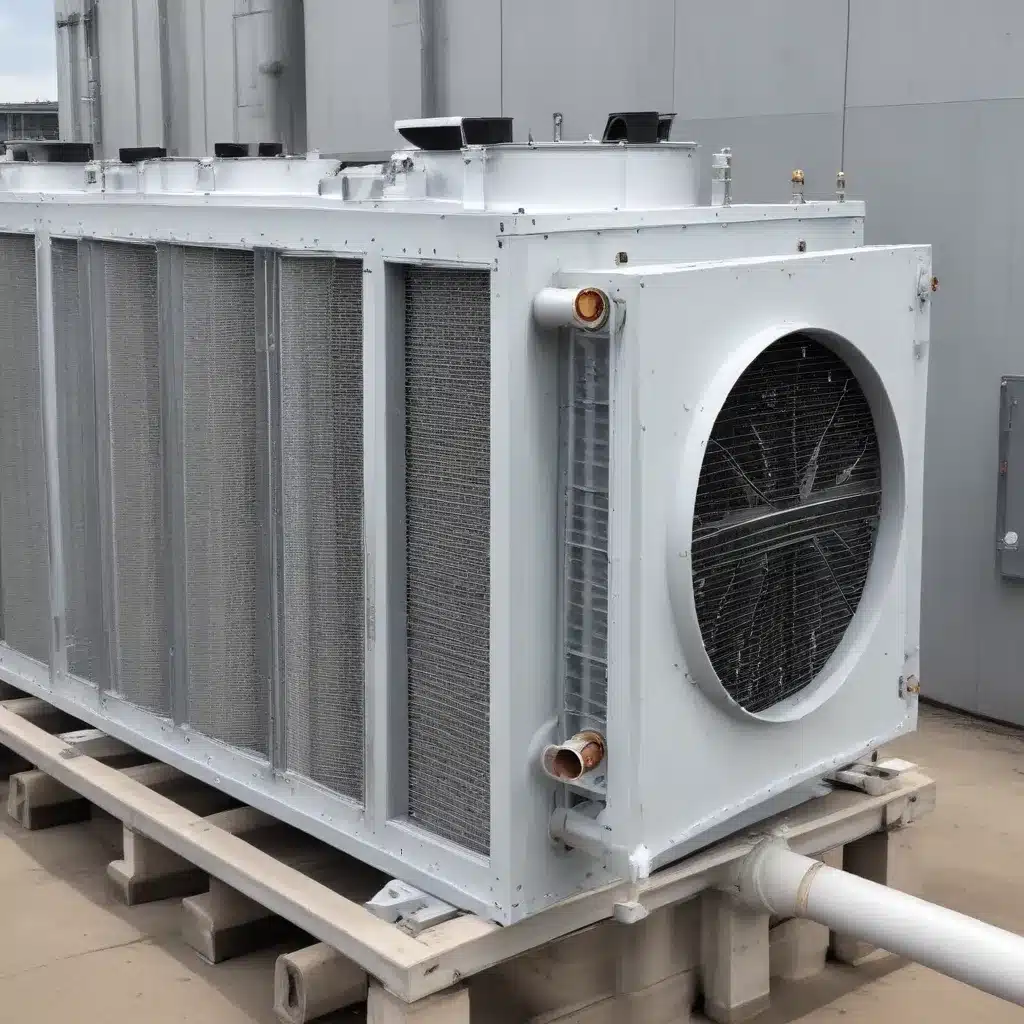
Optimizing Thermal Efficiency and Sustainability in Air-Cooled Heat Exchangers
As a seasoned expert in the field of air-cooled heat exchangers, I’ve witnessed the remarkable advancements in thermal engineering and the growing emphasis on sustainable design. In this comprehensive article, we’ll explore practical tips and in-depth insights to enhance the performance and environmental footprint of these critical heat transfer components across various industries.
Embracing Renewable Energy Integration
One of the key strategies for improving the sustainability of air-cooled heat exchangers involves the integration of renewable energy sources. By leveraging technologies such as solar heating and cooling systems, geothermal heating and cooling, or biomass-powered heating, we can significantly reduce the reliance on fossil fuels and lower the carbon emissions associated with HVAC systems.
Integrating renewable energy sources not only directly benefits the heat exchanger’s performance but also contributes to the broader sustainability of the entire system. For example, desiccant heating, cooling, and ventilation can enhance the energy efficiency of air-cooled heat exchangers by actively managing moisture levels and reducing the load on the cooling or heating components.
Optimizing Heat Recovery and Waste Heat Utilization
Another crucial aspect of enhancing air-cooled heat exchanger designs is the effective recovery and utilization of waste heat. By incorporating advanced heat recovery technologies, such as air-to-air heat exchangers or heat pipe heat exchangers (HPHEs), we can capture and repurpose the thermal energy that would otherwise be lost to the environment.
These innovative heat recovery systems not only improve the overall efficiency of the air-cooled heat exchanger but also contribute to the broader sustainability of the HVAC system. For instance, liquid-to-air membrane energy exchangers and porous metal foam heat exchangers can enhance energy recovery while also reducing the environmental impact by minimizing waste heat discharge.
Enhancing Indoor Air Quality and Microbial Contamination Control
One of the critical considerations in air-cooled heat exchanger design is the preservation of indoor air quality (IAQ) and the mitigation of microbial contamination. As the “respiratory system” of buildings, HVAC systems, including air-cooled heat exchangers, can potentially harbor and spread various infectious diseases, as highlighted by recent pandemic outbreaks such as COVID-19 and SARS.
To address this challenge, researchers have developed innovative strategies, such as the integration of UV-C lamps, pressure control, and humidity management within the HVAC system design. Additionally, the incorporation of advanced air filtration and purification technologies, including photocatalysis, plasma, and physical adsorption, can effectively mitigate the spread of airborne contaminants and safeguard occupant health.
By prioritizing IAQ and implementing comprehensive microbial control measures, air-cooled heat exchanger designs can contribute to the overall well-being and productivity of building occupants, aligning with the broader goal of sustainable HVAC system development.
Optimizing Water Recovery and Sustainability
Water sustainability is another crucial aspect of air-cooled heat exchanger design. These systems act as “air-water harvesting” devices, condensing water vapor from the air, which can be a valuable resource, especially in water-scarce regions.
Researchers have explored various condensate recovery systems and their potential applications, ranging from irrigation to potable water supply. By incorporating dedicated condensate collection and treatment systems into the air-cooled heat exchanger design, we can unlock the water recovery potential and contribute to the overall sustainability of the building or facility.
Moreover, the integration of water recovery systems can have a positive impact on the energy efficiency of the HVAC system, as the reclaimed water can be used for evaporative cooling or other applications that reduce the overall thermal load.
Embracing Smart Technologies and Predictive Controls
The advancement of smart technologies and predictive control strategies offers significant opportunities for enhancing the sustainability of air-cooled heat exchanger systems. Cloud-based building automation and control systems (BACS) can enable adaptive and responsive HVAC management, optimizing energy consumption, indoor comfort, and overall system performance based on real-time data and weather conditions.
By incorporating artificial intelligence and machine learning algorithms into the control systems, air-cooled heat exchangers can autonomously adjust their operation to achieve the desired thermal performance while minimizing energy use and environmental impact.
These intelligent control systems can also facilitate the integration of renewable energy sources, optimize heat recovery, and enhance indoor air quality, further contributing to the overall sustainability of the HVAC system.
Retrofitting and Upgrading Existing Air-Cooled Heat Exchangers
While designing new air-cooled heat exchangers with sustainability in mind is crucial, the retrofitting and upgrading of existing systems also present significant opportunities for improving energy efficiency and environmental performance.
Studies have shown that simple modifications, such as implementing smart monitoring and control technologies, optimizing air flow, repairing duct leaks, and upgrading fan components, can result in substantial energy savings and reduced environmental impact.
Additionally, the integration of heat recovery systems, the utilization of variable-speed drives, and the incorporation of renewable energy sources can transform existing air-cooled heat exchangers into more sustainable and efficient systems.
By prioritizing the retrofitting and upgrading of existing air-cooled heat exchangers, we can significantly reduce the global energy consumption and environmental footprint associated with HVAC systems, contributing to a more sustainable built environment.
Conclusion: Embracing a Holistic Approach to Sustainable Air-Cooled Heat Exchanger Design
In the pursuit of enhancing air-cooled heat exchanger designs for improved thermal performance and reduced environmental impact, a holistic approach is essential. By seamlessly integrating renewable energy sources, optimizing heat recovery and waste heat utilization, prioritizing indoor air quality and microbial contamination control, and leveraging smart technologies and predictive controls, we can create a new generation of sustainable air-cooled heat exchangers.
Furthermore, the retrofitting and upgrading of existing systems play a crucial role in mitigating the global environmental impact of HVAC systems, showcasing the importance of a comprehensive strategy that addresses both new and existing air-cooled heat exchanger installations.
As an industry expert, I encourage you to explore these strategies and consider their implementation in your air-cooled heat exchanger projects. By embracing sustainable design principles and prioritizing energy efficiency, indoor comfort, and environmental responsibility, we can collectively drive the transformation towards a more sustainable future for our built environment.
For more information and resources on air-cooled heat exchangers, please visit https://www.aircooledheatexchangers.net/.

